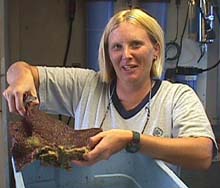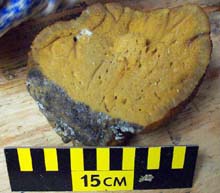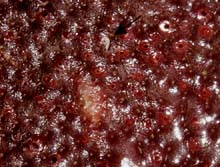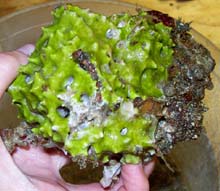
Stacie Crowe holds the stinking sponge Ircinia campana collected during the first dive of the mission at St. Augustine Scarp. Click image for larger view.
Sponge Commensals
July 28, 2002
Stacie Crowe, Marine Biologist
South Carolina Department of Natural Resources
”I hoped for parasites and for tenants but not until I began to pull the sponge apart, did I realize the multitude of pulsating lives in these hidden catacombs.”
-- W. Beebe (1937)
![]() Watch a video of a sponge being collected. (mp4, 3.3 MB)
Watch a video of a sponge being collected. (mp4, 3.3 MB)
Clear blue skies and calm seas welcomed the first full day of dive operations for Islands in the Stream 2002. During the first dive of this mission, scientists used the Johnson-Sea-Link II (JSL II) submersible’s manipulator arm to collect two specimens of the stinking vase sponge, Ircinia campana. These specimens were collected at a depth of 165 feet from the St. Augustine Scarp off Jacksonville, Florida. When the sponges were examined closely, several small amphipod crustaceans and polychaete worms were emerging from the oscules, which are large exhalent openings on the surface of the sponge. These organisms live inside the sponge in a unique commensal relationship. Commensalism is an intimate symbiotic association between two organisms where one party benefits, while the other is not significantly affected.

The fire sponge, Tedaria ignis, has large internal canals and has been reported as a host to several commensal organisms. Click image for larger view.
Commensal relationships are common between sessile plants or animals, such as sponges, algae, and corals, and motile organisms, including fish and many invertebrates. Marine environments, such as coral reefs, exhibit numerous examples of these associations.
Undersea Hotels
Marine sponges are abundant on coral reefs and often make attractive hosts to a variety of commensal organisms. In previous studies, scientists have identified several invertebrates that are often involved in commensal relationships with sponges, including shrimp, amphipod crustaceans, polychaete worms, and brittlestars. A single sponge can host anywhere from just a few to several hundred commensal organisms depending on its size and shape, which makes them worthy of being described as “living hotels.” The internal architecture of a sponge is composed of meandering canals and large cavities, both of which make convenient hiding spaces for commensal organisms!Life in a Sponge
Sponges have several qualities that make them excellent hosts for commensal organisms. In addition to providing a convenient refuge from predators, which may increase chances of survival for the guest, they also supply the commensal with nutrients and particulate organic matter via feeding/respiratory currents. As the term commensalism literally means, “eating from the same table,” you can see why a sponge is an excellent choice of host for a commensal organism.
A commensal amphipod ( end of black arrow) emerges from a stinking vase sponge collected during the first dive of the mission at St. Augustine Scarp. Click image for larger view.
In addition to hosting individual organisms, sponges may also play host to entire communities of endocommensal species—those commensal organisms living entirely within a host. The volume of the host sponge, as well as size and distribution of internal channels, are factors that may determine community structure and population size within any given sponge. When entire communities of organisms gather together, a foundation for advanced social behaviors is created. Some examples of social behavior of commensal organisms within sponges include extended parental care and eusociality. Eusociality is defined by three characteristics—cooperative brood care, reproductive division of labor, and overlap of generations. Recently, the snapping shrimp, Synalpheus regalis, which is a sponge commensal, was reported as the first eusocial marine organism that we know of. Many marine crustaceans, such as amphipods, tanaids, and isopods, exhibit varying levels of extended parental care, during which parents care for their offspring for a certain period of time after hatching. So, life within a sponge is more than comfortable living space and an endless supply of food. There is the possibility of an exciting social life, too!

This particularly colorful sponge was a surprise find at 198 ft. Most sponges at this depth are not so vibrantly colored. Click image for larger view.
Unanswered Questions
Details of commensal associations have not been thoroughly studied in marine ecosystems. Yet, they are important in determining and evaluating evolutionary change, in addition to maintaining ecosystem balance. Since the early 1900s, scientists have been exploring sponges to find out just exactly who lives in them and why. There are still several unanswered questions, such as, why does an organism pick a particular sponge to live in? And, what are the relationships between the physical characteristics of the sponge and the community within? Hopefully, sponges collected during this mission will provide researchers with answers to some of these questions.Sign up for the Ocean Explorer E-mail Update List.














































